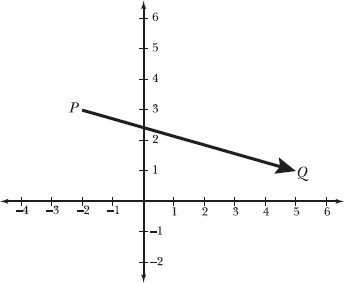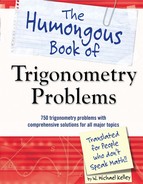Using initial and terminal points
Note: Problems 14.1–14.5 refer to vector v, which has initial point P = (–2,3) and terminal point Q = (5,1).
14.1 Plot v in the coordinate plane.
Vector v begins at point P = (–2,3) and extends to point Q = (5,1), where it terminates, as illustrated in the following graph. Note that the initial and terminal points are not explicitly depicted on the graph of the vector.
In other words, just draw an arrow whose pointy end is the terminal point. Don’t draw dots on the graph to represent the initial and terminal points of the vector.

Note: Problems 14.1–14.5 refer to vector v, which has initial point P = (–2,3) and terminal point Q = (5,1).
14.2 There are two ways to name a vector. In this problem, the vector is defined using the single letter v. Identify the other, equally valid, name for the vector.
In this problem, vector v is assigned a name, but you can also identify a vector according to its initial and terminal points. Because v has initial point P and terminal point Q, you can refer to v as ![]() . (Some textbooks use a slightly different arrow to denote a vector:
. (Some textbooks use a slightly different arrow to denote a vector: ![]() .) The first letter in the name must be the initial point of the vector, so
.) The first letter in the name must be the initial point of the vector, so ![]() is not the same vector as v; they point in opposite directions.
is not the same vector as v; they point in opposite directions.
Note: Problems 14.1–14.5 refer to vector v, which has initial point P = (–2,3) and terminal point Q = (5,1).
14.3 Verify that the vector with initial point R = (0,5) and terminal point S = (7,3) is equivalent to v and explain your answer.
Equivalent vectors have the same length and direction. However, you do not need to calculate the lengths (or magnitudes) of two vectors to determine whether or not they are equivalent. You simply need to compare the horizontal and vertical changes exhibited by both vectors.
If you travel along v from P to Q, you move 7 units to the right and 2 units down. To calculate the change in x (horizontal change), subtract the x-coordinate of P from the x-coordinate of Q. Similarly, calculate the change in y (vertical change) by subtracting the corresponding y-coordinates.
![]()
Now calculate the changes in x and y that occur as you travel from the initial point to the terminal point of ![]()
![]()
Although v and ![]() appear in different locations on the coordinate plane, they both describe a vector that travels 7 units to the right and 2 units down. Thus, the vectors are equivalent.
appear in different locations on the coordinate plane, they both describe a vector that travels 7 units to the right and 2 units down. Thus, the vectors are equivalent.
Note: Problems 14.1–14.5 refer to vector v, which has initial point P = (–2,3) and terminal point Q = (5,1).
14.4 Let w represent a vector that is equivalent to v and has initial point (–1,0). Identify the terminal point of w.
Let (x, y) represent the terminal point of w. As Problem 14.3 explains, equivalent vectors exhibit the same changes in x and y as you travel from their initial to their terminal points. Furthermore, Problem 14.3 states that v exhibits a +7 change in x and a –2 change in y.
Let (x, y) represent the terminal point of w. Calculate the changes in x and y for vector w by subtracting the coordinates of its initial point (–1, 0) from the corresponding coordinates of its terminal point (x, y). Recall that the change in x is equal to 7; the change in y is equal to –2.

Thus, the terminal point of w is (6,–2). As you travel along the vector to this coordinate from initial point (–1,0), you move 7 units right and 2 units down.
Note: Problems 14.1–14.5 refer to vector v, which has initial point P = (–2,3) and terminal point Q = (5,1).
14.5 Assume z is the opposite vector of v. Identify the initial and terminal points of z.
Vector v has initial point P and terminal point Q. Reverse those points to identify the opposite vector z. In other words, the initial point of z is Q and the terminal point is P. A vector and its opposite have the same length but opposite directions.
The vector begins at initial point M = (0,6) and extends toward its terminal point N = (–3,–1), as illustrated in the following graph.

Note: In Problems 14.6–14.7, M = (0,6) and N = (–3,–1).
14.7 Construct a vector v that is equivalent to ![]() and plot it on the coordinate plane.
and plot it on the coordinate plane.
There is more than one correct answer to this problem.
In the diagram below, ![]() is illustrated as a dotted vector. It is equivalent to v, which has initial point (3,2) and terminal point (0,–5). Both vectors travel left 3 units and down 7 units as you trace the path from their initial to terminal points.
is illustrated as a dotted vector. It is equivalent to v, which has initial point (3,2) and terminal point (0,–5). Both vectors travel left 3 units and down 7 units as you trace the path from their initial to terminal points.

There is no single correct solution to this problem; any vector with a terminal point 3 units left of, and 7 units below, its initial point is a valid solution.
14.8 Given P = (1.5, –3.5), Q = (–4, 9.5), R = (13, 6), and S = (7.5, 19), determine whether or not ![]() and
and ![]() are equivalent vectors and explain your answer.
are equivalent vectors and explain your answer.
Subtract the x- and y- coordinates of each vector’s initial point from the coordinates of its terminal point to determine whether the vectors demonstrate the same changes in x and y.

Both vectors travel left 5.5 units and up 13 units from their initial to terminal points, so they are equivalent.
14.9 Given ![]() , the vector illustrated below, identify the terminal point of the equivalent vector v, which has initial point (9,–8).
, the vector illustrated below, identify the terminal point of the equivalent vector v, which has initial point (9,–8).

Vector ![]() has initial point A = (2,–2) and terminal point (0,4). Thus, it exhibits a horizontal change of 0 – 2 = –2 and a vertical change of 4 – (–2) = 6. You are given an initial point of (9,–8) for equivalent vector v. Let (x,y) represent its terminal point. Recall that equivalent vectors exhibit the same horizontal and vertical changes.
has initial point A = (2,–2) and terminal point (0,4). Thus, it exhibits a horizontal change of 0 – 2 = –2 and a vertical change of 4 – (–2) = 6. You are given an initial point of (9,–8) for equivalent vector v. Let (x,y) represent its terminal point. Recall that equivalent vectors exhibit the same horizontal and vertical changes.

The terminal point of v is (7,–2).
Note: In Problems 14.10–14.11, assume that ![]() and
and ![]() are equivalent vectors, such that A = (–4, 11), B = (8, –3), C = (x – 1, 3x), and D = (4x, y + 2).
are equivalent vectors, such that A = (–4, 11), B = (8, –3), C = (x – 1, 3x), and D = (4x, y + 2).
14.10 Calculate x.
Calculate the horizontal change exhibited by each vector.
![]()
Make sure to distribute the negative sign to both terms in the parentheses: x and –1.
Equivalent vectors have equivalent horizontal changes, so 12 = 3x + 1. Solve this equation for x.

Note: In Problems 14.10–14.11, assume that ![]() and
and ![]() are equivalent vectors, such that A = (–4, 11), B = (8, –3), C = (x – 1, 3x), and D = (4x, y + 2).
are equivalent vectors, such that A = (–4, 11), B = (8, –3), C = (x – 1, 3x), and D = (4x, y + 2).
14.11 Calculate y.
Calculate the vertical change exhibited by each vector.
![]()
Equivalent vectors have equivalent vertical changes, so –14 = y + 2 – 3x. According to Problem 14.10, x = 11/3. Substitute that value into the equation and solve for y.

